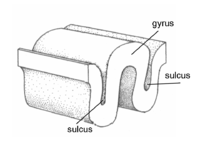
Photo from wikipedia
Reduced placental blood flow results in placental ischemia, an initiating event in the pathophysiology of preeclampsia, a hypertensive pregnancy disorder. While studies show increased mortality risk from Alzheimer's disease, stroke,… Click to show full abstract
Reduced placental blood flow results in placental ischemia, an initiating event in the pathophysiology of preeclampsia, a hypertensive pregnancy disorder. While studies show increased mortality risk from Alzheimer's disease, stroke, and cerebrovascular complications in women with a history of preeclampsia, the underlying mechanisms are unknown. During pregnancy, placental ischemia, induced by reducing uterine perfusion pressure (RUPP), leads to cerebral edema and increased blood-brain barrier (BBB) permeability; however whether these complications persist after delivery is not known. Therefore, we tested the hypothesis that placental ischemia contributes to postpartum cerebral edema and neuroinflammation. On gestational day 14, time-pregnant Sprague Dawley rats underwent Sham (n = 10) or RUPP (n = 9) surgery and brain tissue collected 2 months post-delivery. Water content increased in posterior cortex but not hippocampus, striatum, or anterior cerebrum following RUPP. Using a rat cytokine multi-plex kit, posterior cortical IL-17, IL-1α, IL-1β, Leptin, and MIP2 increased while hippocampal IL-4, IL-12(p70) and RANTES increased and IL-18 decreased following RUPP. Western blot analysis showed no changes in astrocyte marker, Glial Fibrillary Acidic Protein (GFAP); however, the microglia marker, ionized calcium binding adaptor molecule (Iba1) tended to increase in hippocampus of RUPP-exposed rats. Immunofluorescence staining revealed reduced number of posterior cortical microglia but increased activated (Type 4) microglia in RUPP. Astrocyte number increased in both regions but area covered by astrocytes increased only in posterior cortex following RUPP. BBB-associated proteins, Claudin-1, Aquaporin-4, and zonular occludens-1 expression were unaltered; however, posterior cortical occludin decreased. These results suggest that 2 months postpartum, neuroinflammation, along with decreased occludin expression, may partly explain posterior cortical edema in rats with history of placental ischemia.
Journal Title: Brain, Behavior, and Immunity
Year Published: 2018
Link to full text (if available)
Share on Social Media: Sign Up to like & get
recommendations!